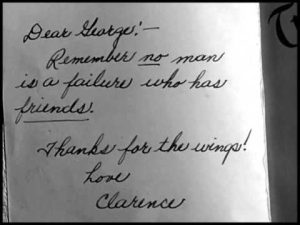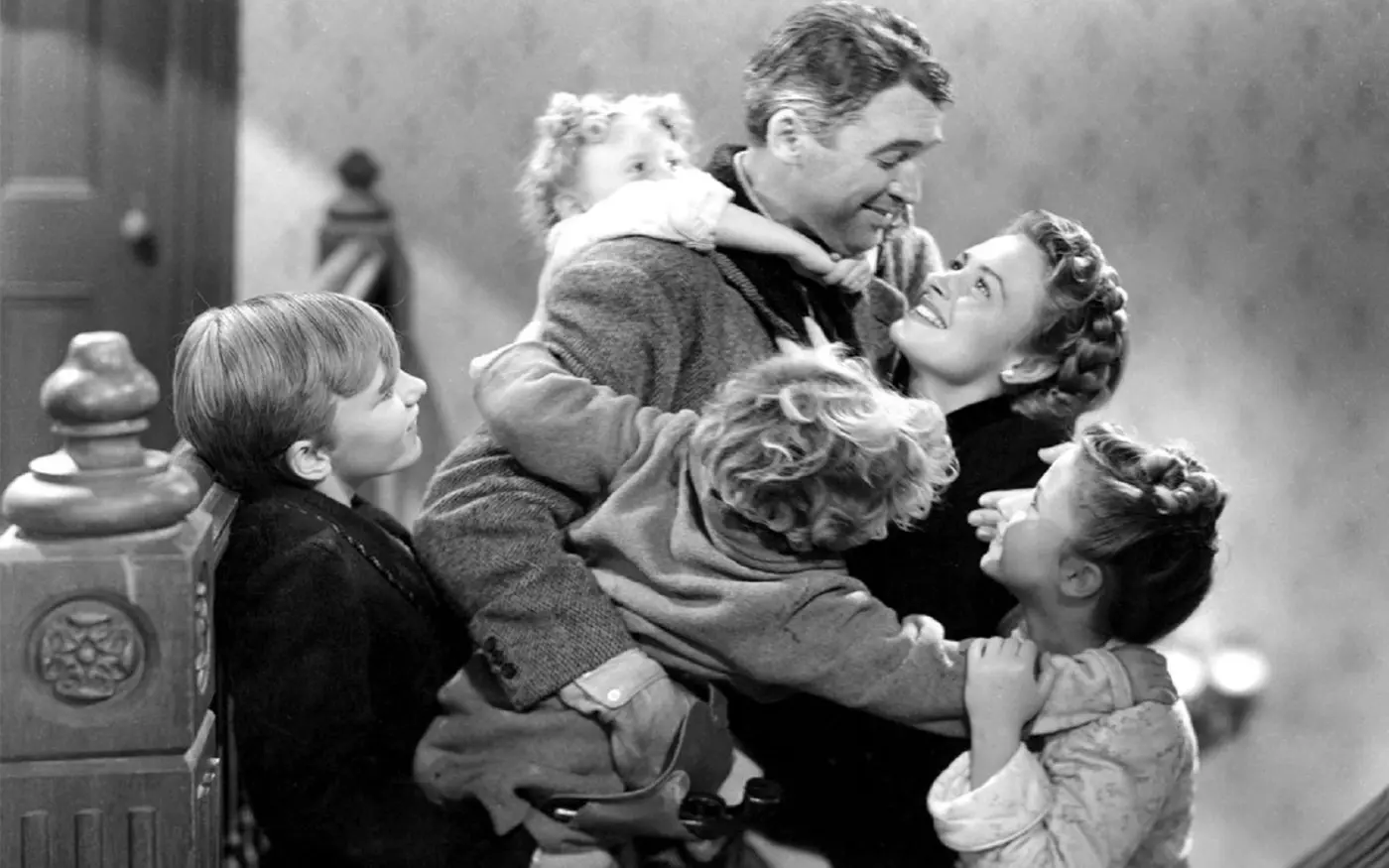“Hope, love, and gratitude amidst greed and moral decay,” is how Ken Boa and Jenny Abel capture the theme of It’s a Wonderful Life in their Guide to Practicing God’s Presence. And that gratitude George grows to embrace can inspire us to rise above our own difficult circumstances and choose gratitude for life.
Before George learns his lesson in gratitude, though, he allows his circumstances to dictate his attitude. With a warrant out for his arrest, his business going under, and his house falling apart, George storms up the staircase, and the rickety-banner knob comes off in his hand. He considers hurling it across the room, but then slams it back on the banister. Continuing his rampage, he yells at his wife, “Why did we have to have all these kids?”
However, after experiencing an alternate reality in which he had never been born, George gains an appreciation for life. Reentering reality, he ascends the staircase to greet his family, and the knob on the banister comes off again. This time, he gratefully kisses it. He takes his family in his arms and lovingly quips, “I could eat you up!”
At that point in the film, George doesn’t know the community is around the corner with the money to pay off his debt. A “happy ending” hasn’t happened yet, but he is happy. His circumstances are still difficult, but his changed perspective brings joy. He uncovers the potent truth that life is beautiful, and he hangs on to that even when everything is going wrong.
Although we can’t change the difficult circumstances of 2020, we can change our perspective on life. Let’s explore the remaining three things that helped George realize life is a gift. (Catch up here if you missed the first three.)
4. Noticing Everyday Wonder
When George’s young daughter Zuzu (Karolyn Grimes) shows him the flower she won at school a few petals fall off, and she asks her dad to “paste it.” George turns away and pretends to fix the flower, secretly slipping the petals into his pocket. He gives the flower back, and they share this sweet moment:
George: Now, will you do something for me?
Zuzu: What?
George: Will you try and get some sleep?
Zuzu: I’m not sleepy. I want to look at my flower.
George: I know-I know, but you just go to sleep, and then you can dream about it, and it’ll be a whole garden.
Zuzu is enamored by her flower—a reminder for us to stop and smell the roses, appreciating beauty with the childlike wonder of a Zuzu. George encourages her wonder, inspiring her to use her imagination to dream about the flower growing into a full garden.
Unfortunately, George does not have such a sweet interaction with his other children. As the weight of his stressful circumstances bears down on him, George lashes out. When his son asks him how to spell “Hallelujah” because he’s writing a play, George snaps, “How should I know? What do you think I am, a dictionary?” His younger son whirls around the room with a toy, and George yells for him to stop. And as his daughter practices a Christmas song on the piano, George shouts, “Janie, haven’t you learned that silly tune yet? You’ve played it over and over again. Now stop it! Stop it!”
George lets his dire circumstances blind him to the wonder and gifts surrounding him: a child’s curiosity about learning to spell for his play script, a little boy’s imagination and enthusiasm, a daughter’s delight in music.
“Mere life is interesting enough,” wrote G.K. Chesterton.[note]Gilbert K. Chesterton, Orthodoxy in Heretics/Orthodoxy (Nashville, TN: Thomas Nelson, 2000), 212.[/note] Humans have “an almost pre-natal leap of interest and amazement.”[note]Ibid.[/note] But we grow older and forget to be amazed. (Notice the toy that George’s son is playing with— a toy vacuum cleaner! Children truly are astonished by life’s seemingly mundane elements.) Noticing beauty and expanding the imagination, even as adults, are key elements to a joy-filled life.
Noticing beauty and expanding the imagination, even as adults, are key elements to a joy-filled life.
Indeed, as George MacDonald elucidates, we should be “occupied with the beautiful.”[note]George MacDonald, A Dish of Orts: Chiefly Papers on the Imagination and on Shakespere [sic] (London: Sampson Low Marston & Company, 1895), 30. Accessed via Google Books.[/note] We should possess a wise and worshipping imagination and “imagine greatly like God” who created us.[note]Ibid., 29.[/note] Then we can have “vivid visions of something beyond, something which eye has not seen.”[note]Ibid., 28.[/note]
We must remember to cultivate a good imagination though. Our imagination, MacDonald says, should not be used to build “airy castles of vain ambition, of boundless riches, of unearned admiration.”[note]Ibid., 30.[/note] We must not waste our imagination on selfish desires—the way the villain Mr. Potter uses his imagination in the film. We should instead use it to conceive “the noblest forms of action.”[note]Ibid., 29.[/note] Like George Bailey and his father do. Mr. Potter derides George’s father for being a “starry-eyed dreamer” who stirs up the people and fills “their heads with a lot of impossible ideas.” But due to George and his father’s hard work and imagination, the ideas were possible. People really could have a nice roof over their heads thanks to Bailey Building and Loan.
When George enters the alternate reality, Zuzu’s petals disappear from his pocket. After seeing what would have happened if he had never been born, he runs back to the bridge and pleads with God for his life back: “I want to live again. I want to live again. Please, God, let me live again.”
5. Fostering Friendships

The message from Clarence to George at the end of the film
As the angel Clarence writes to George: “No man is a failure who has friends.” George has a strong community around him. But when he needs help, he tries to figure it out on his own. He even turns to the evil Mr. Potter for help instead of turning to his friends.
At the end of the film, after the community finds out George is in trouble, they come through for him. His friends prove that “two are better than one … for if either of them falls, the one will lift up his companion” (Ecclesiastes 4:9–10).
You might have a strong sense of individualism, yet you must not let that turn into pride—it’s okay to reach out to others for help. We are made as communal beings and called to bear one another’s burdens (Galatians 6:2).
“I don’t want to be a burden to anyone, though,” you might think. Nonsense. It’s a blessing to get to help others. Watch the ending scene of It’s a Wonderful Life again and notice how happy the community is when they get to help George. When you don’t let people help with your burdens, you’re taking away an opportunity for them to be blessed! You’re taking away the chance for them to observe God working in your life.
When you don’t let people help with your burdens, you’re taking away an opportunity for them to be blessed!
6. Seeking God
“Show me the way. I’m at the end of my rope. Show me the way, God,” George cried out.
George turned to God in his pain, which is the most important way to realize that life is wonderful and worth living.
Turning to God in your pain is the most important way to realize that life is wonderful.
Unlike George, though, don’t wait until you’re at the end of your rope to seek God! Scripture tells us to seek Him continually (see 1 Chronicles 16:11).
Seeking God might be the most obvious (or possibly trite-sounding) action on this list, yet it can be the hardest to remember and put into practice. If you need some fresh ideas for how to seek God in daily life, Ken Boa and Jenny Abel have prepared a 52-week guide to living in God’s presence: A Guide to Practicing God’s Presence (there’s also an app version). It includes 100+ practices (including watching and discussing films like It’s a Wonderful Life) to increase your awareness of God’s presence. It is the companion training guide that goes along with the book Life in the Presence of God: Practices for Living in Light of Eternity by Ken Boa.
Following in George Bailey’s footsteps, let’s step away from the bridge of despair. Our hope and joy can be renewed daily as we seek our wonderous Creator who gave us this gift of life.
Guest post by Hannah Zarr.
Hungry for more? Devour the below videos and articles while you eat a Christmas cookie!
- Rewriting Your Broken Story: The Power of an Eternal Perspective by Ken Boa. Just as George Bailey had to rewrite his broken story by gaining a new perspective, we too can repair our broken stories by embedding them in God’s story—the greatest story ever told. This book can show you how to rewrite the broken stories of 2020 by reflecting on God’s story.
- Christmas archives: don’t miss these past articles and teaching videos by Ken Boa! Plenty to choose from to help you reflect on Christ this Christmas, such as “The Season of Advent” video, “The Return of the Bethlehem Star” article, and “The Mystery of the Incarnation” article.
- If you’d like to learn how to go deeper into film as we did for It’s a Wonderful Life, check out these articles: “How to Read a Film” and “What Makes a Good Movie?” by Ken Boa.



